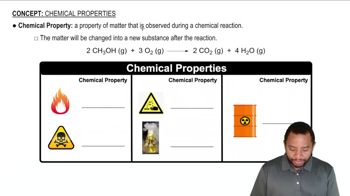Sulfuric acid is a component of acid rain formed when gaseous sulfur dioxide pollutant reacts with gaseous oxygen and liquid water to form aqueous sulfuric acid. Write the balanced chemical equation this reaction. (Note: this is a simplified representation of this reaction.)
Ch.4 - Chemical Reactions and Chemical Quantities

Chapter 4, Problem 15
In a popular classroom demonstration, solid sodium is added to liquid water and reacts to produce hydrogen gas and aqueous sodium hydroxide. What is the balanced chemical equation for this reaction?
 Verified step by step guidance
Verified step by step guidance1
Identify the reactants and products in the reaction: solid sodium (Na), liquid water (H2O), hydrogen gas (H2), and aqueous sodium hydroxide (NaOH).
Write the unbalanced chemical equation: Na(s) + H2O(l) -> H2(g) + NaOH(aq).
Balance the equation by ensuring the number of atoms of each element is the same on both sides. Start with sodium (Na): 2 Na(s) + H2O(l) -> H2(g) + 2 NaOH(aq).
Balance the hydrogen atoms. There are 2 hydrogen atoms in H2O and 2 in H2, so adjust the water molecules: 2 Na(s) + 2 H2O(l) -> H2(g) + 2 NaOH(aq).
Finally, check the oxygen atoms. There are 2 oxygen atoms on both sides, so the equation is balanced: 2 Na(s) + 2 H2O(l) -> H2(g) + 2 NaOH(aq).
Key Concepts
Here are the essential concepts you must grasp in order to answer the question correctly.
Chemical Reactions
A chemical reaction involves the transformation of reactants into products through the breaking and forming of chemical bonds. In this case, sodium (Na) reacts with water (H2O) to produce hydrogen gas (H2) and sodium hydroxide (NaOH). Understanding the nature of reactants and products is essential for writing balanced chemical equations.
Recommended video:
Guided course

Chemical Properties
Balancing Chemical Equations
Balancing a chemical equation ensures that the number of atoms for each element is the same on both sides of the equation, adhering to the law of conservation of mass. This involves adjusting coefficients in front of compounds to achieve equal atom counts, which is crucial for accurately representing the reaction.
Recommended video:
Guided course

Balancing Chemical Equations
Sodium Hydroxide Formation
Sodium hydroxide (NaOH) is formed when sodium reacts with water, resulting in a strong base that dissociates in solution. Recognizing the products of the reaction, including the formation of NaOH and hydrogen gas, is vital for understanding the implications of the reaction, such as its exothermic nature and the release of flammable hydrogen.
Recommended video:
Guided course

Enthalpy of Formation
Related Practice
Textbook Question
1
rank
Textbook Question
Nitric acid is a component of acid rain that forms when gaseous nitrogen dioxide pollutant reacts with gaseous oxygen and liquid water to form aqueous nitric acid. Write the balanced chemical equation for this reaction. (Note: this is a simplified representation of this reaction.)
1
rank
Textbook Question
When iron rusts, solid iron reacts with gaseous oxygen to form solid iron(III) oxide. Write the balanced chemical equation for this reaction.
Textbook Question
Write the balanced chemical equation for the fermentation of sucrose (C12H22O11) by yeasts in which the aqueous sugar reacts with water to form aqueous ethanol (C2H5OH) and carbon dioxide gas.
